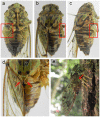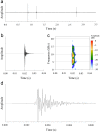How do "mute" cicadas produce their calling songs?
- PMID: 25714608
- PMCID: PMC4340955
- DOI: 10.1371/journal.pone.0118554
How do "mute" cicadas produce their calling songs?
Abstract
Insects have evolved a variety of structures and mechanisms to produce sounds, which are used for communication both within and between species. Among acoustic insects, cicada males are particularly known for their loud and diverse sounds which function importantly in communication. The main method of sound production in cicadas is the tymbal mechanism, and a relative small number of cicada species possess both tymbal and stridulatory organs. However, cicadas of the genus Karenia do not have any specialized sound-producing structures, so they are referred to as "mute". This denomination is quite misleading, as they indeed produce sounds. Here, we investigate the sound-producing mechanism and acoustic communication of the "mute" cicada, Karenia caelatata, and discover a new sound-production mechanism for cicadas: i.e., K. caelatata produces impact sounds by banging the forewing costa against the operculum. The temporal, frequency and amplitude characteristics of the impact sounds are described. Morphological studies and reflectance-based analyses reveal that the structures involved in sound production of K. caelatata (i.e., forewing, operculum, cruciform elevation, and wing-holding groove on scutellum) are all morphologically modified. Acoustic playback experiments and behavioral observations suggest that the impact sounds of K. caelatata are used in intraspecific communication and function as calling songs. The new sound-production mechanism expands our knowledge on the diversity of acoustic signaling behavior in cicadas and further underscores the need for more bioacoustic studies on cicadas which lack tymbal mechanism.
Conflict of interest statement
Figures






References
-
- Gerhardt HC, Huber F. Acoustic Communication in Insects and Anurans: Common Problems and Diverse Solutions. Univ. Chicago Press, Chicago; 2002.
-
- Nowicki S, Searcy WA. Song function and the evolution of female preferences: why birds sing, why brains matter. Annals of the New York Academy of Sciences. 2004;1016: 704–723. - PubMed
-
- Alexander RD. Sound production and associated behavior in insects. The Ohio Journal of Science. 1957;57: 101–113.
Publication types
MeSH terms
LinkOut - more resources
Full Text Sources
Other Literature Sources

